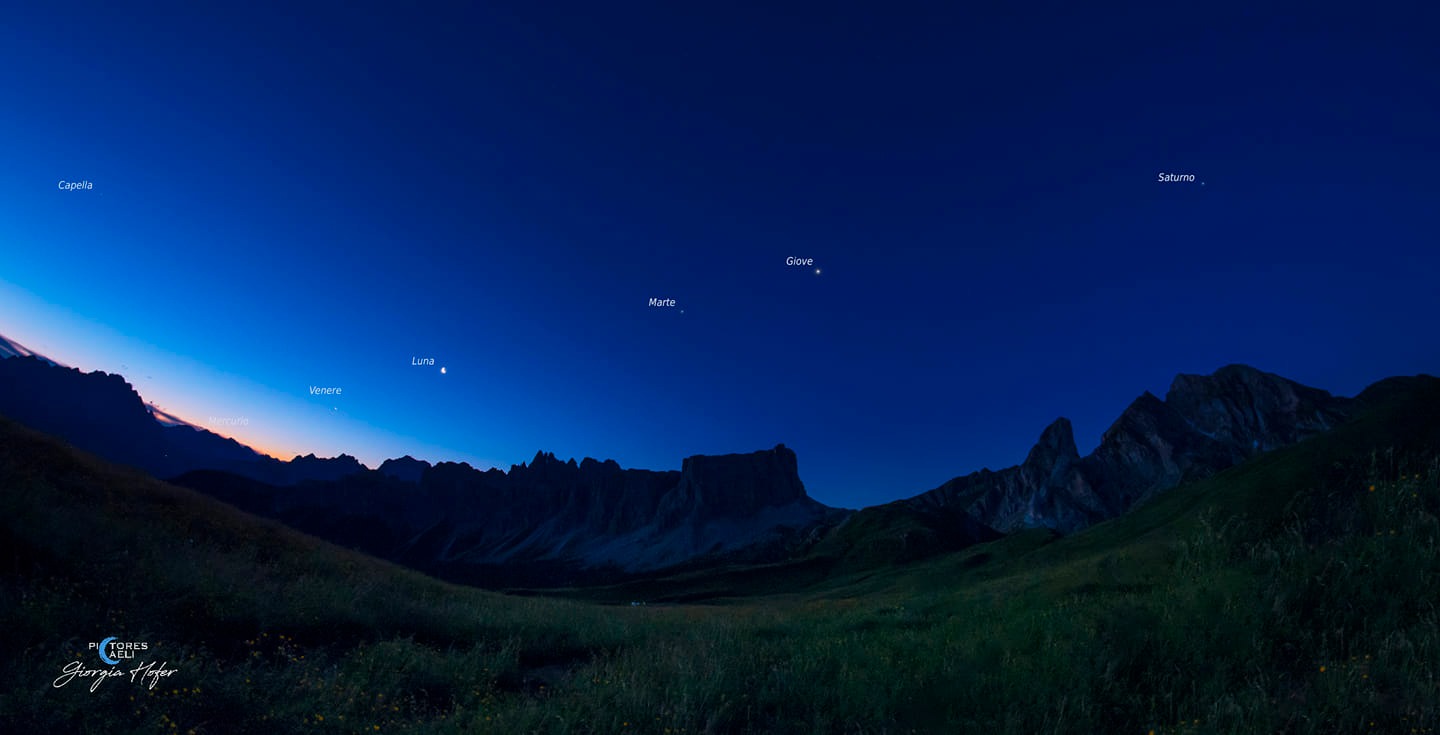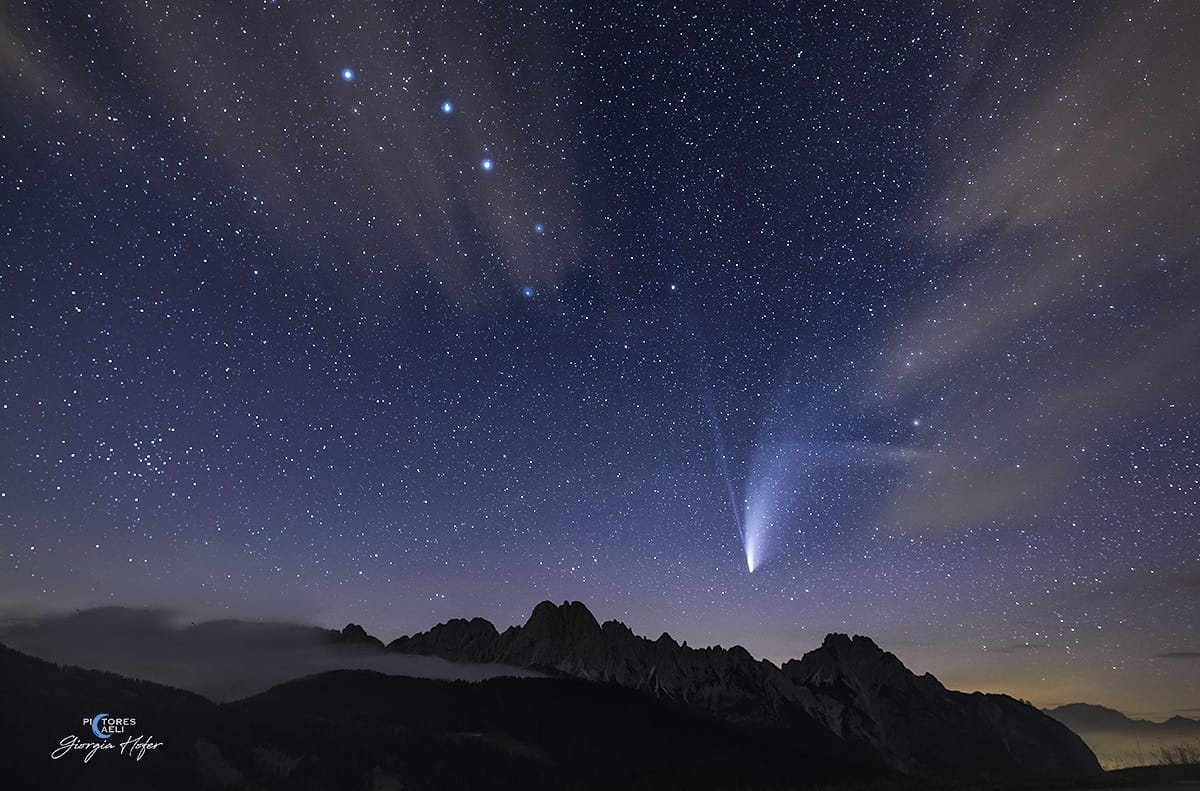Stardust and eternity – 3.3.3
Planets, comets, meteors and meteor showers (falling stars)
Apart from stars, several other celestial objects that may look like them are visible to the naked eye in the night sky. More specifically, five of the eight planets in our solar system – Mercury, Venus, Mars, Jupiter and Saturn – are known as bright “wandering stars” since ancient times. Indeed, while stars seem to move together in the night sky at the same speed, presenting themselves in exactly the same overall pattern every night, planets behave differently. As planets orbit the Sun, they constantly shift their positions with respect to the “fixed stars” or star constellations from night to night throughout the year. This is why the word planet comes from the Greek and means “wanderer”. Besides this typical behaviour, planets differ from stars as they do not twinkle but appear steady, being relatively closer to us and disc-shaped – therefore they do not not undergo the refraction from the Earth’s turbulent atmosphere that affects distant pinpoint stars. Finally, unlike regular stars, brightness of planets varies in a regular cycle, for they do not produce light but reflect back into space part of the light they receive from the Sun (the amount of sunlight they reflect is called “albedo”). This variation also depends on their distance from the Sun and the relative positions of the planet and Earth in their orbits.
All planets follow the same path across the sky, an imaginary line called “ecliptic” – the projection of the plane of the Earth’s orbit around the Sun. Mercury, the small lunar planet that orbits closest to the Sun, can only be observed near the horizon, right before sunrise or sunset. Venus, the second planet from the Sun, is much easier to observe: it is the brightest star-like object in the sky – also due to its high albedo – and appears far above the horizon. Mars, although less bright than Venus, is easily recognisable due to its reddish hue. Jupiter and Saturn, the farthest but largest planets of the solar system, are also quite bright and appear yellowish. A sixth planet, Uranus, is barely visible to the naked eye and was only discovered in 1781 by William Herschel, with the aid of a telescope. Neptune, the most distant planet in our solar system, is the only planet invisible to the naked eye; it was only discovered in 1846.
Another class of celestial object that can sometimes be observed (roughly once a year) with the naked eye are comets. These “dirty snowballs” come from a region bordering the solar system, known as Kuiper belt; it contains millions of cometary objects, which generally disintegrate within a few hundred thousand years as they repeatedly pass close to the Sun. When one of them is diverted into the inner solar system and approaches the Sun, it may appear in the night sky as a diffuse object with one or two beautiful long tails formed as the Sun’s heat vaporizes its ice and releases dust particles, which are then swept away in an anti-Sun direction by the pressure of solar radiation.
“Meteors” – from the Greek “high in the air”, or “shooting stars” – are much easier to spot, especially when the sky is darker. These are not exactly celestial bodies, rather small fragments of asteroids and comets crossing the Earth’s atmosphere, called “meteroids”. Their size ranges from millimetres to tens of metres. As the Earth moves along its orbit, its atmosphere continuously collects this debris at the astonishing rate of about 100 tonnes per day! When a meteoroid enters the atmosphere, it appears like bright streak dalling suddenly into the night sky, due to its rapid motion and because it is heated to incandescence by colliding with molecules in the upper atmosphere. If the meteoroid survives until it reaches the surface, it is called a “meteorite”. Meteors are best seen when they appear in “showers”; this occurs when the Earth crosses the orbit of a comet or asteroid, passing through the flow of their debris. Several comets have orbits that approach the Earth’s orbit every year, producing annual meteor showers – the most famous of which is perhaps the Perseids meteor shower, which occurs mid-August and originates from the orbiting debris of comet Swift-Tuttle. The meteoroids of a meteor shower enter the atmosphere moving in the same direction and thus appear to originate from the same point in the sky, called the “radiant” of the meteor shower.


Further resources
Links below will redirect you to external websites. In accordance with the European data protection declarations, we would like to point out that by clicking on these links you may send data to external providers. We cannot prevent that.
Images
![]() Kuiper Belt and Oort Cloud (ESA)
Kuiper Belt and Oort Cloud (ESA)
![]() Kuiper Belt Objects (ESO)
Kuiper Belt Objects (ESO)
![]() The Structured Tails of Comet NEOWISE (Zixuan Lin, Beijing Normal U.)
The Structured Tails of Comet NEOWISE (Zixuan Lin, Beijing Normal U.)
![]() Trajectory and tails of a comet (LAPS, University of Colorado)
Trajectory and tails of a comet (LAPS, University of Colorado)
![]() Rosetta Comet (ESA/Rosetta/NAVCAM)
Rosetta Comet (ESA/Rosetta/NAVCAM)
![]() The Nucleus of comet Halley (ESA)
The Nucleus of comet Halley (ESA)
![]() Jets from Comet Churyumov-Gerasimenko (ESA/Rosetta/MPS for OSIRIS Team; MPS/UPD/LAM/IAA/SSO/INTA/UPM/DASP/IDA)
Jets from Comet Churyumov-Gerasimenko (ESA/Rosetta/MPS for OSIRIS Team; MPS/UPD/LAM/IAA/SSO/INTA/UPM/DASP/IDA)
![]() Comets and meteor showers (SAO Encyclopedia of Astronomy)
Comets and meteor showers (SAO Encyclopedia of Astronomy)
![]() Tau Herculid Meteors over Kitt Peak Telescopes (Jianwei Lyu, Steward Obs., U. Arizona)
Tau Herculid Meteors over Kitt Peak Telescopes (Jianwei Lyu, Steward Obs., U. Arizona)
![]() Perseid Map (NASA)
Perseid Map (NASA)
![]() Perseids from Perseus (Petr Horálek)
Perseids from Perseus (Petr Horálek)
![]() A Chicago Meteorite Fall (Ivan and Colby Navarro)
A Chicago Meteorite Fall (Ivan and Colby Navarro)
![]() Kuiper Belt’s ice cores (ESO/M. Kornmesser)
Kuiper Belt’s ice cores (ESO/M. Kornmesser)
Videos
![]() Asteroids, Comets, and Meteors (The Documentary Channel)
Asteroids, Comets, and Meteors (The Documentary Channel)
![]() Meteor Showers 101 (National Geographic)
Meteor Showers 101 (National Geographic)
![]() Comets (Crash Course Astronomy)
Comets (Crash Course Astronomy)
![]() Meteors (Crash Course Astronomy)
Meteors (Crash Course Astronomy)
On line resources
![]() Comets (NASA science)
Comets (NASA science)
Further readings
![]() Hunting and Imaging Comets (Martin Mobberley)
Hunting and Imaging Comets (Martin Mobberley)
![]() Blazing a Ghostly Trail: ISON and Great Comets of the Past and Future (Peter Grego)
Blazing a Ghostly Trail: ISON and Great Comets of the Past and Future (Peter Grego)
![]() Cosmic Debris What It Is and What We Can Do About It (Jonathan Powell)
Cosmic Debris What It Is and What We Can Do About It (Jonathan Powell)
![]() Field Guide to Meteors and Meteorites (O. Richard Norton, Lawrence Chitwood)
Field Guide to Meteors and Meteorites (O. Richard Norton, Lawrence Chitwood)
![]() Falling Stars: A Guide to Meteors and Meteorites (Michael D. Reynolds)
Falling Stars: A Guide to Meteors and Meteorites (Michael D. Reynolds)
![]() Meteors and how to Observe Them (Robert Lunsford)
Meteors and how to Observe Them (Robert Lunsford)
![]() Meteor Showers: An Annotated Catalog (Gary W. Kronk)
Meteor Showers: An Annotated Catalog (Gary W. Kronk)
Teaching Material
![]() Falling stars teaching aids (Aerospace.org)
Falling stars teaching aids (Aerospace.org)
For Kids
![]() Comets, Asteroids, and Meteors (Learn Bright)
Comets, Asteroids, and Meteors (Learn Bright)
![]() What’s a Meteor Shower? (Astronomy for Kids)
What’s a Meteor Shower? (Astronomy for Kids)
![]() All About Comets for Kids: Astronomy and Space for Children (FreeSchool)
All About Comets for Kids: Astronomy and Space for Children (FreeSchool)
![]() What is a comet? (NASA)
What is a comet? (NASA)
![]() What is a meteor shower? (NASA)
What is a meteor shower? (NASA)
